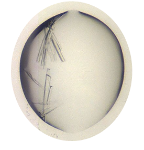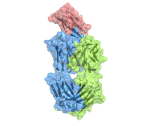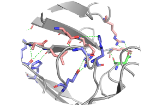____________________________________
Industrial Liaison Group:
Tel: +44 (0) 1235 778797
E-mail: [email protected]
Programmed Cell Death Protein 1 (PD1) is a receptor protein on the surface of T cells which is involved in the suppression of the immune system. Blocking PD1 has been a successful approach to enhance anti-cancer immune responses, and there is also significant interest in developing molecules that can trigger PD1 signalling to treat autoimmune diseases.
Biotechnology company, MiroBio Ltd., which was acquired in August 2022 by Gilead Sciences, had developed an antibody that binds to human PD1 and triggers its signalling function. Even though the amino-acid sequence of the binding region was known, there was a need to model the Antibody-PD1 binding interface in detail to determine the binding epitope and important interactions. However, the company had no internal facilities to conduct their own structural studies.
MiroBio used Diamond’s services to get the structural data they needed. A sample of the antibody’s Fragment Antigen Binding (FAB) region complexed to PD1 protein was sent to Diamond and scientists from the Industrial Liaison Team used it to set up crystallisation experiments at Diamond’s Crystallisation Facility.
These initial experiments yielded small and thin crystals that were optimised for size and shape with custom made screens and crystal seeding. After optimisation, a number of crystals were selected for X-ray diffraction screening at Diamond’s I04 beamline.
The diffraction experiments confirmed that they were protein crystals, and several datasets were collected. The best dataset, in terms of data quality and resolution, was used for structure determination by molecular replacement, followed by several rounds of interactive model building and refinement.
The final model contained one FAB and one PD1 molecule and showed their binding interface at atomic resolution.
Even though MiroBio did not have any previous experience of working with structural biology, they were able to commission Diamond to generate structural data on their behalf. The Industrial Liaison team at Diamond handled everything from the crystallisation experiments and data collection through to data processing and analysis, so just from a protein sample they were able to achieve an atomic resolution model of their FAB-PD1 complex.




We wanted to solve the crystal structure of our antibody interacting with PD1, and immediately contacted Diamond. They were very responsive, collaborative, and communicative throughout the whole process and produced great results!
Dr Lynne Murray, Vice President, Research Inflammation, Gilead Sciences
Diamond Light Source is the UK's national synchrotron science facility, located at the Harwell Science and Innovation Campus in Oxfordshire.
Copyright © 2022 Diamond Light Source
Diamond Light Source Ltd
Diamond House
Harwell Science & Innovation Campus
Didcot
Oxfordshire
OX11 0DE
Diamond Light Source® and the Diamond logo are registered trademarks of Diamond Light Source Ltd
Registered in England and Wales at Diamond House, Harwell Science and Innovation Campus, Didcot, Oxfordshire, OX11 0DE, United Kingdom. Company number: 4375679. VAT number: 287 461 957. Economic Operators Registration and Identification (EORI) number: GB287461957003.